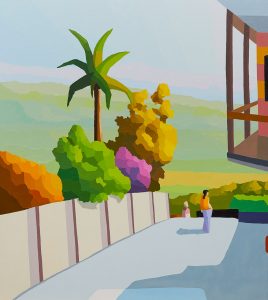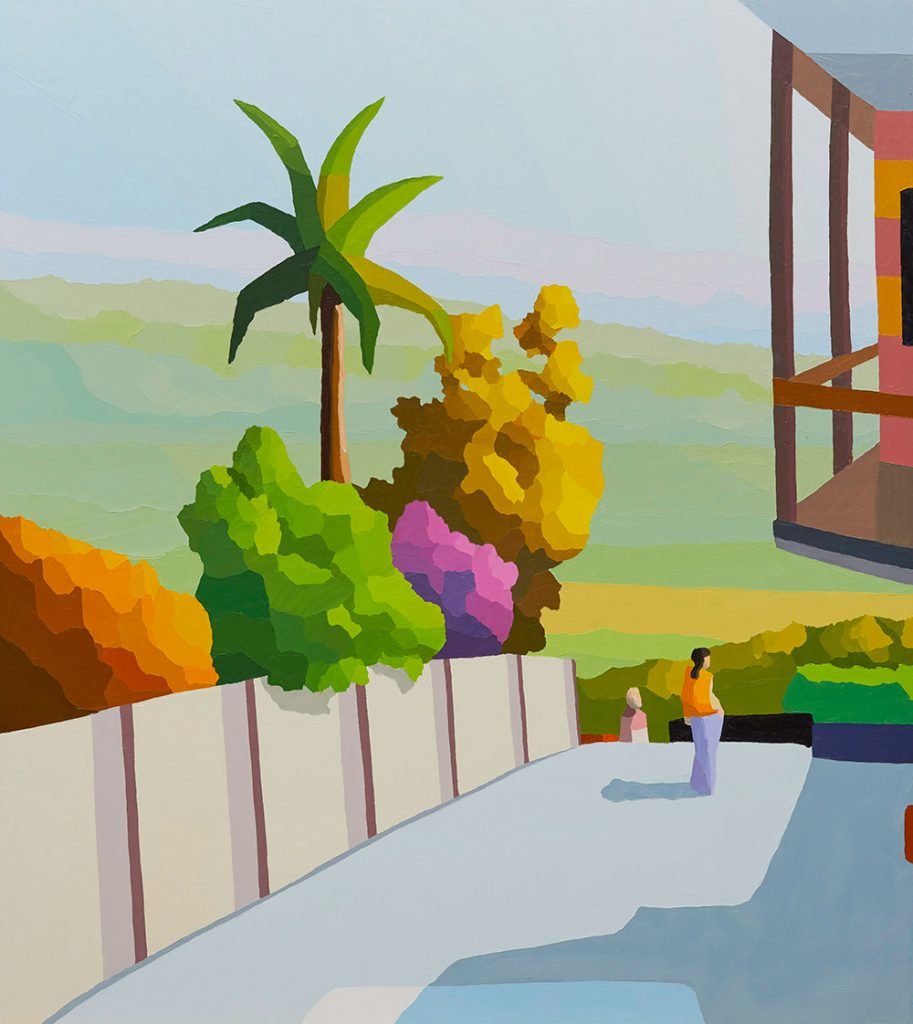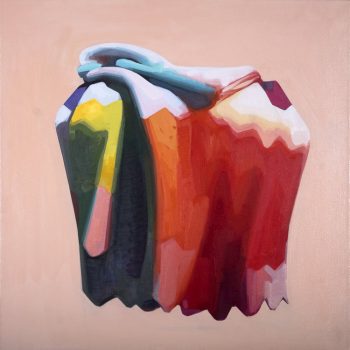Noontime Embers, 2017, oil on linen, 137.0 x 122.0cm
The first thing to clarify is that interpreting art is highly subjective and can be provocative. The information sent to us from the artwork will be interpreted according to the unique course our life has taken: personal experiences, interests, education, parenting and the myriad cultural factors that impact who we are. In summary, interpreting art is based on the interpreter’s, point of view, and that point of view is derived from the above aspects which form an individual’s life.
In Noontime Embers ‘The flattened shapes create an ambiguous image where a narrative is unfolding.’
Noontime Embers is also a summary of the arbitrary decisions made by the artist. The title was chosen randomly based on the music he was listening to during the process of painting. While acknowledging arbitrariness as a factor, there is no doubting that Muir’s motivation is the investigation of urban landscapes and the endless potential that genre offers.
Muir’s landscapes appear as quasi-utopian in that the content is idealised, crisp and clean with no extraneous matter, untidy details or obvious detritus. Although, this is a steralised view of urban life, it is not hopelessly removed from reality. This is affirmed in the glow of optimism which imbues the work and the presence of people casually going about their daily lives.
Moreover, this world offers a comparatively balanced view between man and nature: apparently ideal worlds which can be related back to personal circumstances, ‘It is perhaps his sons who can take some credit for his paintings’ unaffected appeal to the playful, inventive possibilities of narrative’
The inventive possibilities of narrative may also play a part in promoting the world around him in a positive light; he is both a Father and a painter. Following on, much of what we impart to our children involves choice; positive or negative. If we engage this rhetoric, Muir is choosing to put a qualified and yet cheerful spin on the urban environment in the 21st century.
Formally the work is structured to be visually pleasing with the central figure flanked, on either side by greenery and a building in an inverted triangular arrangement. The world opens up and out from the relaxed figure who is at the centre of this universe.
The suburban vista oversees an undulating, spartan landscape into the distance. The forms are similarly proportional; soft and sharp-edged sculptural shrubs and trees and the gentle immaculate landscape in the background.
The one conditional element impacting the serenity of the scenic landscape is the corner of the building which juts into the central space of the composition and is characterised by strong horizontals and verticals. There is an element of intrusiveness in the robust form jutting into this perfect world: perhaps a comment on the suburban growth of large cities further and further inland; western Sydney for example.
The indeterminate nature of the building might also mean that most of us have to earn a living which can decidedly impact our utopian dreams. However, the overall implication is of an almost-perfect suburban life transitioning harmoniously from one season to the next.
Conversely, one cannot conceive of or appreciate utopian qualities without acknowledging their binary opposites. On the one hand, the use of warm and cool colours in almost equal proportions combined with a languid figure in the centre of a pristine distilled view of urbanity hints at an even path through life, at innocence, virtuousness and a level of wealth. Add in the vibrant contemporary palette and a youthful vibe is set up.
In terms of binary opposites, the utopian heaven pictured above is inconceivable without a simultaneous wafting sense of its opposite – hell. There is a direct correlation between the two; one concept cannot exist without the other.
 In the immediate neighbourhood of Noontime Embers, there is a near-complete absence of the contrary aspects of city life; there are no rubbish bins, power poles, street lights or signs, cars, take-away shops, road works, buses or school children – there is no overtly messy, ugly, intrusive or second rate suburban imagery to contradict this sublime view of life.
In the immediate neighbourhood of Noontime Embers, there is a near-complete absence of the contrary aspects of city life; there are no rubbish bins, power poles, street lights or signs, cars, take-away shops, road works, buses or school children – there is no overtly messy, ugly, intrusive or second rate suburban imagery to contradict this sublime view of life.
However, the very fact that the viewer receives such a distinct and filtered version of reality is in itself a comment on its unreality.
Adopting a cynical view, it could be said the work is pitched at Millennials with money to burn, no real problems, no kids and the world-at-their-feet: a vision of life ahead for the twenty-something figure imagining herself surrounded by beauty, entrenched in her own wonderful reality.
These are the next generation of up and coming art buyers.
Symbolism works on many levels in Noon Embers and has been discussed above, however, the content, the formal modes of representation and the palette symbolise more broadly the intricate connection between man and nature.
“Michael Muir was the winner of the Mosman Art Prize 2014 and has been a finalist in a number of awards over the past decade including the Wynne, Sulman and Fleurieu Art Prizes. His work is represented in Australia’s Artbank collection and private collections throughout Australia and internationally.”
Michael Muir is represented by Jan Murphy Gallery Brisbane
































